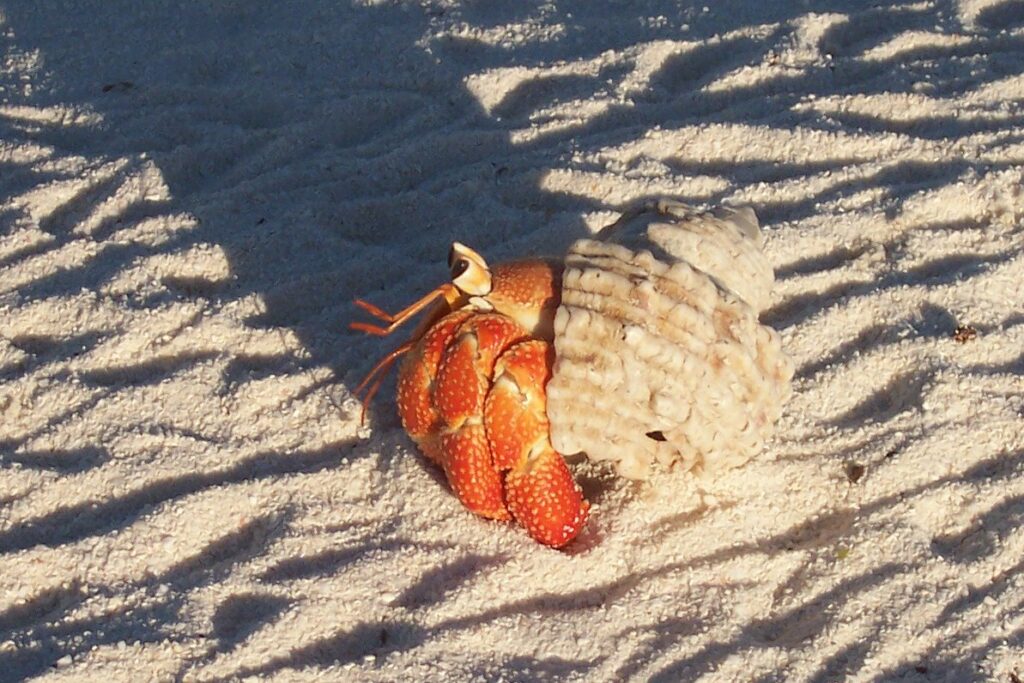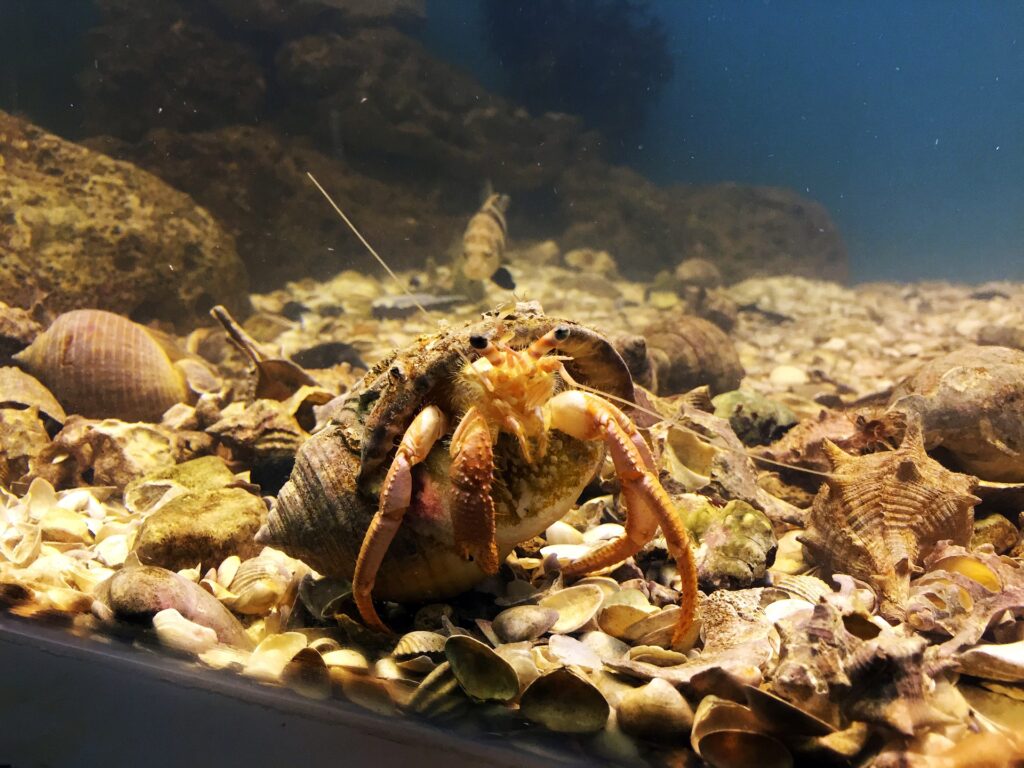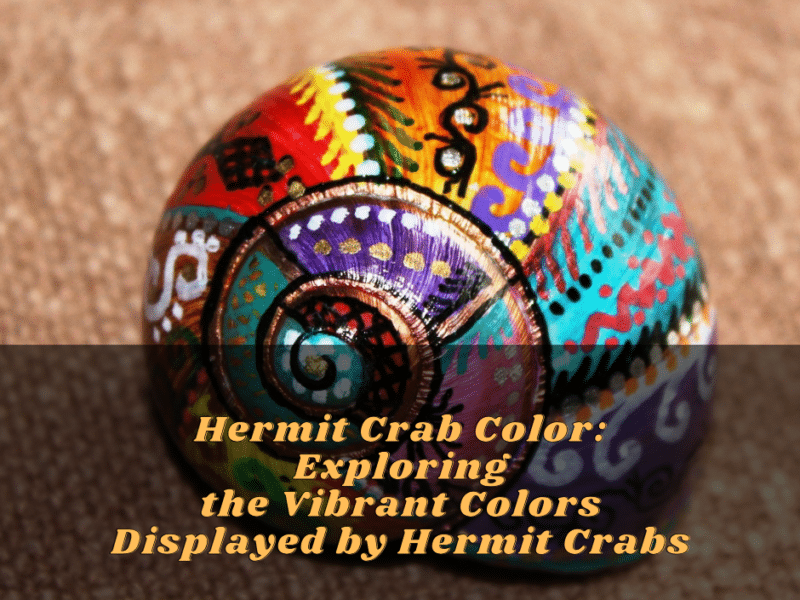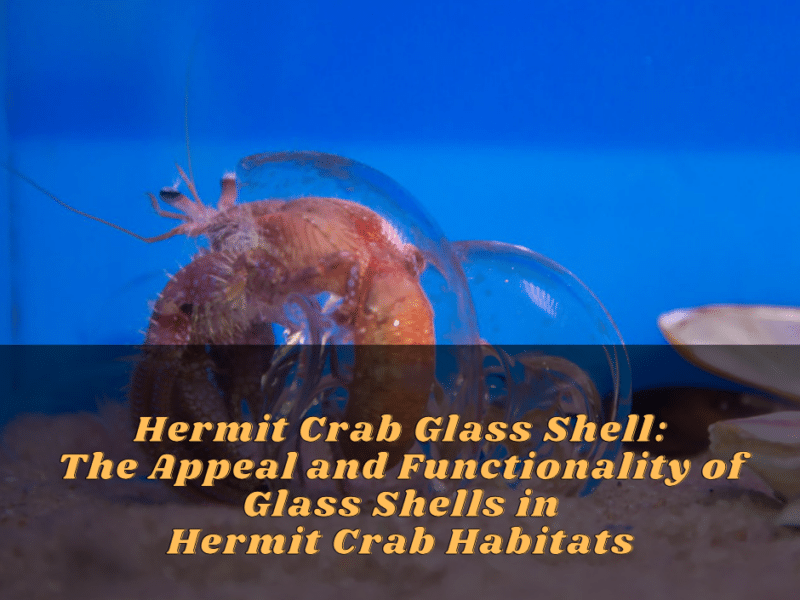Does Hermit Crab Need Water: Understanding The Importance Of Hydration For Hermit Crabs
Importance Of Hydration For Hermit Crabs
Hydration is vital for the overall well-being and survival of hermit crabs. Just like any living creature, hermit crabs require water to maintain various physiological functions in their bodies. Without proper hydration, they can experience significant health problems and even face the risk of death.
One of the primary reasons why water is crucial for hermit crabs is that it helps them regulate their body temperature. These fascinating creatures are ectothermic, which means they rely on external heat sources to maintain their body temperature. Water provides a cooling effect, allowing them to regulate their body heat and avoid overheating.
Furthermore, water is essential for hermit crabs’ respiratory system. They have modified gills that require moisture to function properly. These gills enable them to extract oxygen from the air, which is vital for their survival. Without adequate moisture, their gills can dry out, leading to respiratory distress.
Hydration also plays a significant role in the molting process of hermit crabs. Molting is a crucial period in their life cycle when they shed their exoskeleton to grow. During this time, they require ample moisture to soften their old exoskeleton and facilitate the shedding process. Without enough water, the molting process can be stressful and potentially fatal for them.
Moreover, hydration helps maintain the health of a hermit crab’s exoskeleton. Their exoskeleton acts as a protective shell, and sufficient moisture ensures its strength and flexibility. Depriving a hermit crab of water can result in a weakened exoskeleton, making them vulnerable to injuries and diseases.
Overview Of The Blog Post
In this blog post, we will delve into the importance of hydration for hermit crabs. We will explore the various reasons why water is essential for their well-being and discuss the consequences of dehydration. Additionally, we will provide tips and guidelines for effectively hydrating your hermit crab to ensure their health and longevity.
Throughout the post, we will emphasize the significance of providing fresh, clean water for your hermit crab and discuss the different methods of delivering water to them. We will also address common misconceptions and mistakes that hermit crab owners make regarding hydration.
Furthermore, we will share insights on how to create a conducive environment for hermit crabs, including humidity levels and suitable water sources. Understanding the specific hydration needs of hermit crabs will enable you to provide the optimal care required to keep them healthy and thriving.
By the end of this blog post, you will have a comprehensive understanding of why hermit crabs need water and how to ensure they receive adequate hydration for their overall well-being and long-term health.
Why Do Hermit Crabs Need Water?
Hermit crabs, like any living creatures, rely on water for their overall well-being and survival. Water plays a crucial role in maintaining various physiological functions in their bodies. Without proper hydration, hermit crabs can experience significant health problems and even face the risk of death.
Water For Drinking And Staying Alive
One of the primary reasons why water is vital for hermit crabs is that it serves as their source of hydration. Just like humans, they need water to survive. Water enables hermit crabs to maintain the balance of fluids in their bodies and ensures the proper functioning of their organs and systems.
In addition to drinking, hermit crabs also use water for bathing. They have gills that need to be moist to extract oxygen from the air. Without adequate moisture, their gills can dry out, leading to respiratory distress. Providing them with a shallow water dish allows them to soak and maintain their gill health, preventing potential respiratory problems.
Water For Shell Moisture And Molting
Hydration is especially crucial for hermit crabs during the molting process. Molting is a vulnerable period in their life cycle when they shed their old exoskeleton to grow. Water plays a vital role in this process by softening their old exoskeleton, making it easier for them to shed it. Sufficient moisture also helps them maintain the health of their new exoskeleton, ensuring its strength and flexibility.
During molting, hermit crabs require a humid environment to prevent their new exoskeleton from drying out. Lack of moisture during this critical stage can lead to their exoskeleton hardening prematurely, causing difficulties and potential injuries during the shedding process. Adequate hydration and humidity help facilitate a smooth molting process and reduce the risks involved.
To provide the optimal hydration for hermit crabs, it is essential to offer them fresh, clean water in a shallow dish that they can access easily. The water should be chlorine-free and free from any contaminants. It is also crucial to regularly change the water to maintain its cleanliness and freshness.
Understanding the importance of hydration for hermit crabs enables you to provide the care they need to thrive. By ensuring they have access to clean water for drinking, bathing, and maintaining shell moisture, you can contribute to their overall well-being and long-term health. Remember to monitor their water intake and provide a suitable habitat with adequate humidity levels to create a conducive environment for these fascinating creatures.
How Do Hermit Crabs Obtain And Store Water?
Hermit crabs, like any living creatures, rely on water for their overall well-being and survival. Water plays a crucial role in maintaining various physiological functions in their bodies. Without proper hydration, hermit crabs can experience significant health problems and even face the risk of death.
Drinking Water From Dishes
One of the primary ways hermit crabs obtain water is by drinking from shallow water dishes provided by their caretakers. These dishes are placed within their habitat and regularly filled with fresh, clean water. Hermit crabs have specialized appendages called maxillipeds that they use to scoop and transport the water towards their mouths. They will drink the water to stay hydrated and maintain the balance of fluids in their bodies.
It is important for caretakers to ensure that the water provided is free from chemicals such as chlorine and any other contaminants. Regularly changing the water is also necessary to maintain its cleanliness and freshness. By offering accessible water sources, caretakers can help hermit crabs fulfill their hydration needs.
Storing Water In Their Shells
In addition to drinking, hermit crabs have a unique way of storing water. They utilize their shells as protective homes and also use them to store water. These shells act as a reservoir, allowing hermit crabs to carry a small amount of water with them wherever they go.
Hermit crabs primarily use the moisture in their shells to keep their gills moist. Their gills are responsible for extracting oxygen from the air, and they need to be kept moist to function properly. Without adequate moisture, the gills can dry out, leading to respiratory distress.
To maintain shell moisture, hermit crabs will periodically dip their bodies into the water dish, soaking their shells and allowing the moisture to seep in. This not only keeps their gills moist but also helps them regulate their body temperature and maintain overall hydration.
Caretakers should ensure that the water dish is shallow enough for hermit crabs to comfortably access and dip their shells into. The water temperature should be suitable for their well-being, neither too hot nor too cold. By providing an accessible and suitable water source, caretakers can support the natural behavior of hermit crabs and help them stay properly hydrated.
Understanding how hermit crabs obtain and store water is crucial for their care and well-being. By providing fresh, clean water dishes and suitable shells, caretakers can contribute to their overall hydration. Remember, proper hydration is vital for hermit crabs’ physiological functions, including respiration and molting. By ensuring they have access to water, caretakers can help these fascinating creatures thrive in their environment.
The Significance Of Moving Water For Hermit Crabs
Hermit crabs, like any living creatures, rely on water for their overall well-being and survival. Water plays a crucial role in maintaining various physiological functions in their bodies. Without proper hydration, hermit crabs can experience significant health problems and even face the risk of death.
Natural Habitat And Water Movement
In their natural habitat, hermit crabs are typically found near bodies of water such as the ocean or coastal areas. These environments provide a constant source of moving water, which is essential for their survival. Moving water provides oxygenation and helps maintain the balance of salts and minerals in their bodies.
In the wild, hermit crabs benefit from the ebb and flow of the tides, which brings in fresh water and removes waste. The movement of water also helps to distribute nutrients and food sources, supporting the overall ecosystem in which they live.
Importance Of Preventing Stagnant Water
When keeping hermit crabs in captivity, it is crucial to recreate their natural environment as closely as possible. This includes providing them with a source of moving water. Stagnant water can lead to various health issues and can be detrimental to their well-being.
Stagnant water does not provide sufficient oxygenation, which can result in respiratory problems for hermit crabs. It can also become a breeding ground for harmful bacteria and other microorganisms that can cause infections and diseases.
To prevent stagnant water, caretakers should consider using water pumps or air stones to create a gentle flow in the water dish. This mimics the natural movement of water and ensures that hermit crabs have access to oxygenated water.
Regular cleaning and water changes are also essential to maintain the cleanliness and freshness of the water. Caretakers should remove any uneaten food or waste promptly to prevent contamination.
It is important to note that while hermit crabs need access to water, they should not be submerged for prolonged periods. They are not aquatic creatures and rely on a combination of air and water to survive.
By understanding the significance of moving water for hermit crabs and taking steps to prevent stagnant water, caretakers can ensure the health and well-being of these fascinating creatures. Creating an environment that closely resembles their natural habitat will help them thrive and lead fulfilling lives in captivity.
Remember, proper hydration is vital for hermit crabs’ physiological functions, including respiration and molting. By providing access to moving water and maintaining its cleanliness, caretakers can contribute to the overall health and happiness of their hermit crabs.
Providing Water For Hermit Crabs In Captivity
Ensuring Access To Clean And Fresh Water
When it comes to keeping hermit crabs in captivity, one of the most important aspects to consider is providing them with access to clean and fresh water. Just like in their natural habitat, water plays a vital role in maintaining their overall health and well-being. Without proper hydration, hermit crabs can suffer from a range of health problems and may even face the risk of death.
To ensure that your hermit crabs have access to clean and fresh water, there are a few key factors to consider. First, it is important to use dechlorinated water. Tap water often contains chlorine, which can be harmful to hermit crabs. By using a water conditioner or allowing tap water to sit out for 24 hours, you can remove any chlorine and make the water safe for your crabs.
Additionally, it is crucial to provide a water dish that is large enough for your hermit crabs to submerge themselves partially. Hermit crabs are not fully aquatic creatures, but they still need to have access to water for their physiological functions. By providing a dish with enough depth, you allow them to hydrate themselves and regulate their body temperature.
Regular cleaning of the water dish is also essential to maintain its cleanliness and freshness. Hermit crabs are known to relieve themselves in their water dish, so it is important to remove any waste promptly to prevent contamination. Changing the water at least every two days and thoroughly cleaning the dish will help ensure that your hermit crabs have access to clean and fresh water at all times.
Factors To Consider In Maintaining Proper Hydration
Proper hydration is vital for the overall well-being of hermit crabs. One of the key factors to consider in maintaining their hydration is humidity. Hermit crabs require a humid environment to thrive, as this helps prevent their gills from drying out. Keeping the humidity level between 70% and 80% is ideal for most hermit crab species.
Apart from humidity, providing access to moving water is also crucial. In their natural habitat, hermit crabs are accustomed to the ebb and flow of the tides, which brings in fresh water and removes waste. Recreating this movement in their water dish can help oxygenate the water and ensure that they have access to clean and oxygenated water.
Another important factor to consider is the type of saltwater solution provided. Hermit crabs need access to natural sea saltwater for their overall health. Using marine salt designed specifically for hermit crab habitats will ensure that they receive the necessary minerals and maintain proper hydration.
By understanding the importance of hydration for hermit crabs and taking steps to provide them with access to clean and fresh water, you can contribute to their overall health and well-being in captivity. Ensuring that they have a proper water source and maintaining the right humidity levels will help them thrive and lead fulfilling lives as your pets.
Conclusion
Understanding the importance of hydration for hermit crabs is crucial for their overall health and well-being. Providing access to clean and fresh water plays a vital role in maintaining their physiological functions and preventing health issues. By ensuring they have a proper water source and maintaining the right humidity levels, you can contribute to their thriving lives as your pets.
Recap Of The Importance Of Hydration For Hermit Crabs
Proper hydration is essential for hermit crabs to survive and thrive. Without access to clean and fresh water, they can suffer from dehydration, which can lead to various health problems and even death. Hydration helps regulate their body temperature, support physiological functions, and prevent their gills from drying out. Maintaining the right humidity levels and providing access to moving water are key factors in ensuring their hydration needs are met.
Tips For Maintaining A Healthy Water Environment
To provide a healthy water environment for your hermit crabs, consider the following tips:
- Use dechlorinated water: Tap water often contains chlorine, which can be harmful to hermit crabs. Use a water conditioner or allow tap water to sit out for 24 hours to remove any chlorine before providing it to your crabs.
- Provide a suitable water dish: Ensure the water dish is large enough for hermit crabs to partially submerge themselves. This allows them to hydrate and regulate their body temperature. Regular cleaning of the water dish is also necessary to prevent contamination.
- Maintain proper humidity levels: Hermit crabs require a humid environment to prevent their gills from drying out. Keep the humidity level between 70% and 80% using a hygrometer or by misting the enclosure regularly.
- Recreate movement in the water dish: Mimic the ebb and flow of the tides by gently moving the water in the dish. This helps oxygenate the water and ensures your hermit crabs have access to clean and oxygenated water.
- Use natural sea saltwater: Hermit crabs need access to natural sea saltwater for their overall health. Use marine salt designed specifically for hermit crab habitats to provide the necessary minerals and maintain proper hydration. Follow the instructions on the product for the correct saltwater concentration.
By following these tips, you can ensure that your hermit crabs have a healthy water environment that meets their hydration needs. This, in turn, contributes to their overall well-being and allows them to lead fulfilling lives as your pets. Remember to monitor their water source regularly and make adjustments as necessary to maintain a clean and fresh water environment.
FAQ: Does Hermit Crab Need Water? Understanding the Importance of Hydration for Hermit Crabs
Q: Why do hermit crabs need water?
A: Water is essential for the survival of all living organisms, including hermit crabs. They need water to drink, store inside their shells for molting, and to keep their soft abdomens moist.
Q: Why is it important to keep hermit crabs hydrated?
A: Keeping hermit crabs hydrated is crucial for maintaining the moisture levels in their soft abdomens, which are protected inside their shells. Hydration helps them stay healthy and ensures their internal organs are well-protected.
Q: How do hermit crabs obtain water in their natural habitat?
A: In the wild, hermit crabs rely on the movement of water. Although they can survive without it in captivity, stagnant water can quickly become unhealthy for them. Providing them with a water source enhances their well-being and prevents boredom.
Q: Can I use sea water for hermit crabs?
A: Yes, sea water can be mixed with regular water following the measurements on the packet to create a suitable saline solution. This replicates their natural habitat and provides them with the necessary minerals.
Q: How should I provide water for my hermit crab?
A: It is recommended to use heavy and solid bowls for water, as hermit crabs love to climb and may tip over lightweight containers. Changing the water daily helps to keep it clean and fresh for them.
Q: Do hermit crabs need humidity as well?
A: Yes, hermit crabs also require humidity, which refers to the moisture in warm air. While they have evolved to breathe air on land, their gills still need moisture. The required humidity levels may vary depending on the species.
Q: Can hermit crabs survive without access to water?
A: While hermit crabs can survive without direct access to water, it is essential to provide them with water to ensure their overall well-being and to mimic their natural habitat. Adequate hydration contributes to their health and longevity.
Q: How often should I feed my hermit crab?
A: Hermit crabs should be fed daily, but in small amounts at a time to ensure the food is fresh. This helps to prevent waste and ensure their nutritional needs are met.
Remember, providing water for your hermit crabs is not just important for their survival but also contributes to their overall health and happiness. Adequate hydration and a suitable water source will help keep your hermit crab thriving in its environment.




